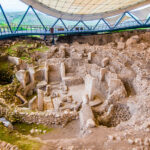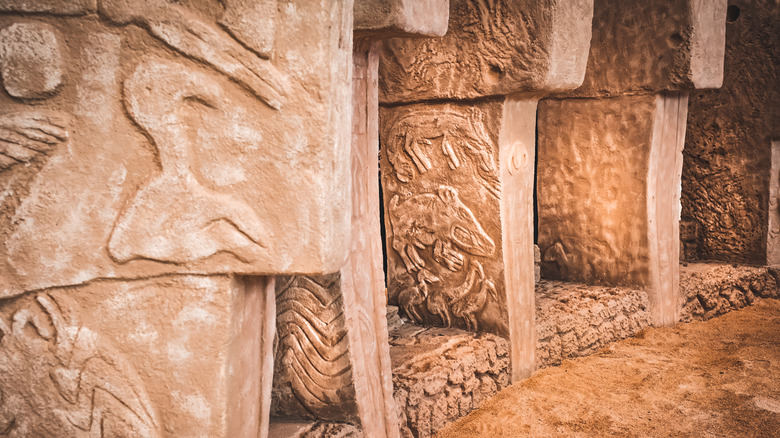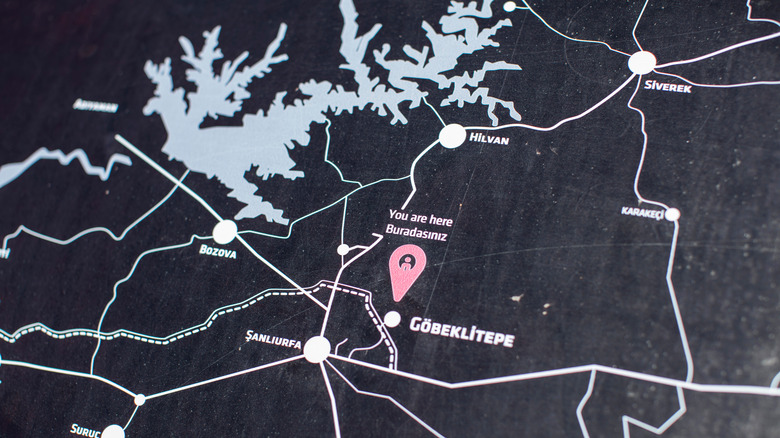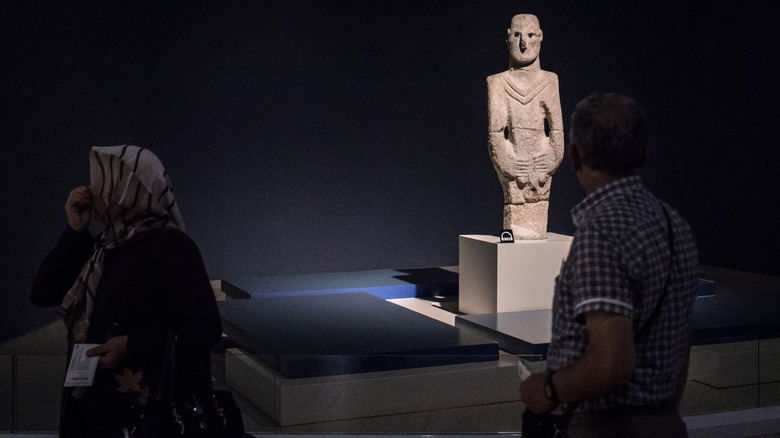
The Ancient Temple Site That Predates Stonehenge By 6,000 Years
When thinking of “ancient” civilizations, lots of folks might think of Ancient Rome from 753 BCE to 476 CE (per History), or the Shang Dynasty from 1600-1050 BCE (per History Hit), or perhaps Ancient Egypt, pharaonic or otherwise, starting 3100 BCE and ending in Cleopatra’s death in 30 BCE (per History Hit). There were plenty of other kingdoms and empires that rose and fell the world over, though, many centered on Mesopotamia in the Middle East, around the Tigris and Euphrates rivers: Sumerian, Akkadian, Babylonian, Hittite, and more.
Artifacts tell the story of these people, but so do written records. Cuneiform, the world’s first writing system, developed from a “half-script” of mere pictographic symbols to a “full-script” of complete sentences, grammatical parts, abstract language, and so on, starting from 3500 BCE in Sumer (per World History). Before this? Well, without writing we’ve got pots, buildings, firepits, and a whole lot of “I don’t know” shoulder shrugs.
But what would you say if we discovered a temple — monolithic, complex, full of multiple chambers, multi-ton stones and stelae (pillars with artwork), even giant cisterns for beer — that dates all the way back to at least 9000 BCE? That’s 6,400 years earlier than the Pyramids at Giza (built around 2600 BCE, per the BBC) and 6,000 years earlier than Stonehenge (built about 3000 BCE, per English Heritage). That’s as far back from us now as we are from the year 13,000 CE.
Such a site exists: Gobekli Tepe in modern-day Turkey.
A cathedral on a hill, crafted of and by stone
Gobekli Tepe is a shocking find not just because of its age, but because of how it completely upends conventional wisdom about humanity’s transition from hunter-gathering to farming and animal husbandry.
Discovered in 1994, as Smithsonian Magazine chronicles, this “cathedral on a hill,” as dubbed by the man who discovered it, Klaus Schmidt, was crafted of stone, using stone. Located near the modern-day city of Urfa in southern Turkey, close to the Syrian border, Gobekli Tepe has undergone extensive, careful excavation year after year, revealing layer upon layer of information about a people so unknown, so ancient, we have no idea who they were, what they were called, or what they called themselves. The name “Gobekli Tepe” is a moniker bestowed by researchers, a nod to its rounded hilltop location, meaning “belly hill.” The site was deemed a UNESCO World Heritage site in 2018.
Fundamentally, Gobekli Tepe is so stunning because archaeologists, researchers, historians, and ethnographers assumed for decades that agriculture, starting with the Agricultural Revolution circa 10,000 BCE (per National Geographic), yielded “civilization.” Folks started planting crops, needed to spend a lot of time doing it, built settlements to stay put and watch the crops, then walls around those settlements, etc. Fast forward 12,000 years and we’ve got Tokyo. Gobekli Tepe suggests the exact opposite: hunter-gatherers banded together to build a structure so important, so integral, that agriculture developed to support a workforce of hundreds of individuals who built it.
A pilgrimage spot of feasting and drinking built by hunter-gatherers
Even though it’s impossible to talk about Gobekli Tepe’s builders beyond our archaeological record — it predates written language by millennia — the site itself is full of details that speak volumes about its purpose.
First of all, Gobekli Tepe was not a permanent settlement, as National Geographic points out. There’s no town around it, no place for a workforce to have lived, slept, nothing. It stands alone — a single, multi-chambered structure of concentric rings bracketed by T-shaped stone pillars along the walls and encircled by rings of higher-and-higher terraces, like a theater. The largest, single, unbroken stone weighs more than 16 tons. There are carvings of hands, people, anthropomorphic animals, geometric symbols, phallic imagery, the same “handbag” designs seen on sites across the world, and more. There are landfill-like areas topped with dirt and full of tens of thousands of animal bones, even those from now-extinct cows, which suggests a lot of feasting or partying went down. There are also huge, 40-gallon stone containers that seemingly held beer.
Gobekli Tepe is located on a hilltop easily seen from the surrounding environment, but in a spot geographically inconvenient for sites such as the “world’s first town” Çatalhöyük, dated back to the tail end of Gobekli Tepe’s likely lifecycle, at 7000 BCE, as Apollo Magazine explains. All in all, it looks like Gobekli Tepe was a site to travel to, like for a pilgrimage or seasonal event.
A cultural unifier during the infancy of agriculture
In the end, it’s not too bizarre to imagine that our forbears — humans anatomically identical to us since around 200,000 BCE (per NPR) — wanted to build a kind of party hut in the middle of nowhere. Burning Man attendees and peyote-loving consciousness-expansion seekers would concur. The difference? It doesn’t take a workforce of hundreds of laborers with hands bloodied from quarrying multi-ton stones and dragging them in the burning heat to host a three-day event. It just takes a tent.
That’s the key point: Gobekli Tepe was built to be as close to eternal as possible, but had no permanent settlement to live at it. Yet, agriculture likely developed to support its workforce during the time of its lengthy building. So when it was complete, did the builders step back, admire the scene, heft their spears, and wave “see you later” to the partiers from other tribes who were planning on coming back starting next vernal equinox, or whatever?
“Partier” is putting it lightly, then. “Devotee” is more like it. As Smithsonian Magazine and National Geographic say, it stands to reason that Gobekli Tepe was a cultural unifier in a region of various human groups. Religious, mythological, historical: Only those kinds of self-affirming narratives could motivate people to build Gobekli Tepe, same as any other monument, whether it be the Pyramids at Giza, Stonehenge, or Lincoln Memorial. Or power, like a “who can bring the most meat” annual flex-a-thon.

How Dogs Actually Played A Role In World War I

This Is Where Jimi Hendrix Is Buried

Why King Carol II Of Romania Renounced His Title

The Untold Truth Of The Waynai Bible

What You Might Not Know About The Roman Catholic Secret Society

The Sad Truth Of The Little Albert Experiment

Does The Bible Ever Mention The Virgin Mary's Death?

The Surprising Place Alcatraz Prison Guards Lived

The True Story Of How Two Fishing Boat Crews Escaped From Real-Life Pirates

What You Didn't Know About Brandon Lee's Engagement

























